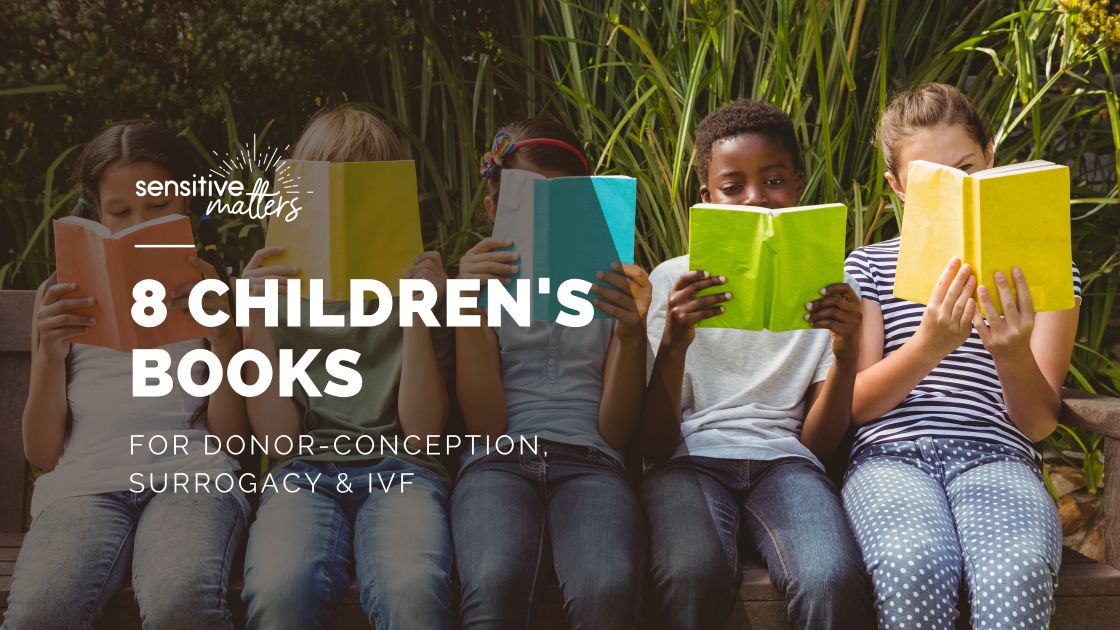8 Children’s books about donor-conception, surrogacy and IVF
Books are a key part of early years learning. It’s no different whether a child is born to a traditional nuclear family, adopted, or conceived through donors or surrogates.
The trouble is, there’s much less educational literature for the latter groups. It can be hard to find resources when you’re ready to start talking to little ones about how they came to be.
Here’s a curated list of early years literature with a special focus on egg donors, sperm donors, and surrogacy, so you can find the style of storytelling that best resonates with you and your children.
You might also want to have a look at our 2023 blog on the best books to explain sperm donor, our favourite books for telling a child about donor egg, children’s books for talking about double donor or embryo donor and books to explain surrogacy to a child.
The Books
Childrens’ books about egg donor conception
A Tiny Itsy Bitsy Gift of Life: An Egg Donor Story by Carmen Martinez-Jover
If your little one was conceived via egg donations and happens to be an animal lover, this might be the perfect read to educate them on their conception.
Written by a psychotherapist and reproductive specialist, it takes a particularly sensitive and intelligent approach to the subject. It’s also full of colour and heartwarming illustrations, so it’s still suitable for children who aren’t quite at reading age yet.
Great for: very young children not quite at reading stage.
The Pea That Was Me: An Egg Donation Story by Kimberly Kluger-Bell
This is a charming tale of a ‘very kind egg donor’ who helped two parents become parents. It’s aimed at ages 3-5, when your child is starting to get a good grasp on the concept of families, and becoming exposed to the home situations of other children at nursery or school.
Great for: children who are just learning to read and speak about their at-home experiences.
Childrens’ books about sperm donor conception
Just The Baby For Me by Barbara Levin
Just The Baby For Me follows a heartwarming narrative that explains women don’t always need husbands to have babies. An honest and charming story, it follows the story of a mum who wants a baby but doesn’t have a husband in her life. It gently explains the process of a doctor putting the sperm in her belly so it could meet the egg.
This is probably one of the best early years books out there for communicating the biological process behind sperm donation, whilst framing it in a sweet and heartwarming way.
Great for: parents who want to use correct biological terms.
Before You Were Born: My Wish for a Baby by Janice Grimes
For a less biological focus, Before You Were Born speaks about donors rather than about eggs and sperm.
This one’s amazing for single mums, because it comes in several different iterations: one for mums who used sperm donation, mums who used embryo adoption, and mums who went through IVF.
There are also versions titled ‘Our Wish For A Baby’ for parents in couples. In fact, there’s a whole series to explore relating to many different methods of conception.
Great for: parents who aren’t quite ready to use words like ‘sperm’ and ‘egg’.
Childrens’ books about surrogacy
The Kangaroo Pouch: A story about surrogacy for young children by Sarah Phillips Pellet
The Kangaroo Pouch is a fun and easy way to communicate the idea of surrogate pregnancy to small children. It’s suitable for under 5s, and has been reviewed by child specialists to enrich it with communicative tools for young children.
Great for: teaching children how to speak about their families to their peers.
The Very Kind Koala: A Surrogacy Story for Children Paperback by Kimberly Kluger-Bell
A book that keeps the surrogacy journey simple and positive, The Very Kind Koala offers a special bonus: a space at the back for you and your children to include their own pictures. This is a great way to help them relate the story of the characters to their own lives, and feel comforted, included, and represented.
Great for: the books interactive collaging opportunity at the end.
More general books for non-traditional families
What Makes a Baby by Cory Silverberg
When the time comes to have ‘the talk’, things can be even more stressful when a child’s conception was through donors or surrogacy. What Makes A Baby is an open, honest, diverse, and inclusive sex education tool, addressing all of the different ways children can come into the world.
Aimed at older children between 4 and 8 (depending on their maturity, curiosity, and your comfort levels), this is a truly great resource for any parent, no matter their mode of conception.
Great for: slightly older kids who are starting to ask questions.
The Magic of You by ... well, you!
The most truly personalised option on this list, The Magic of You allows you to create and present the story of your child’s conception in a totally unique way.
Once you select your family’s setting, it implements your very own story into a beautifully bound book, to read together through the years, and cherish forever.
The Magic of You provides story outlines for heterosexual, same sex and single parent families – all of which can be edited to tell your children their very own tale.
Great for: any family who wants to create a personalised book that tells their child’s unique story of how they came to be.
We hope this review has provided you with a good starting point for your educational reading journey with your little ones.
Alternatively, if you would like help someone create their child’s own Magic of You story, you can view our gift cards here.
